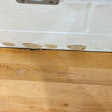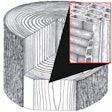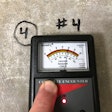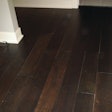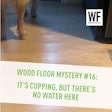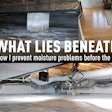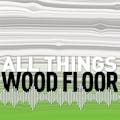The Problem
Recently, I was called to inspect a floor for homeowners who had just moved into a five-year-old house. After living there for six months, their dining room floor buckled approximately 2 inches off of the subfloor.
The Procedure
The floor was solid ¾-by-2¼-inch factory-finished red oak. It had been installed professionally by flooring contractors approximately three years prior. The installation was a standard staple-down over OSB. The homeowners contacted several local flooring stores and spoke to many contractors trying to find an explanation, never receiving a satisfactory answer.
The Cause
After arriving at the home and visually inspecting the floor, I noticed that the installation began tight against the existing ceramic floor in the hallway. Initially, I imagined that this inspection would be an easy case of the floor expanding with nowhere to go on the opposite wall, causing it to buckle up. However, when I removed the wall base, I found a ½-inch expansion space had been left. Okay, now further investigative techniques were needed. Why did this floor buckle three years after the initial installation? All moisture readings and humidity levels on the main floor were within acceptable levels on the day of inspection. The nailing schedule was checked with "rare earth" magnets and found to be perfect. The basement was also inspected and found to be finished and completely furnished, except in the furnace room area, which was located directly beneath the buckled area upstairs. There was a sump pump present next to the furnace. Moisture readings taken from the basement framework were approximately 2 percent greater than those taken on the main level.
The homeowner and I then sat down and began the interview stage of the inspection. My curiosity spiked when I learned that part of the basement was not finished when the homeowners moved in; in fact, they had closed in the furnace room when they first took possession of the home. I then continued my inspection and found that the final three rows in the buckled area had been glued to the subfloor with a premium construction adhesive.
This floor had nowhere to expand to across the widths of the boards. Red oak has a dimensional change coefficient factor of 0.00369, so it doesn't take much moisture change for this floor to move. After the furnace room below had been closed in, moisture concentrated in this area, and the weakest link allowing the floor to move was up.
How to Fix the Floor
The first corrective measure was to ventilate the furnace room to circulate the air and existing moisture so that it was consistent with the rest of the home. The dining room floor was repaired by removing the three glued rows and by removing and replacing the buckled area. I recommended new boards for the replacement, as reinstalling the same boards could cause further issues—the integrity of the board tongues may have been jeopardized by the original staples. The removed rows could then be replaced in accordance with the manufacturer's instructions and without the use of construction adhesive over the last rows.
In the Future
Don't underestimate the movement of hardwood. Any species of wood flooring requires expansion— especially across the board widths. This floor had the appropriate gap left for expansion; however the construction adhesive prevented the boards from taking advantage of it.




















